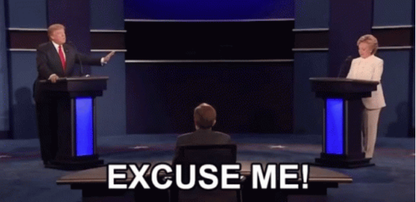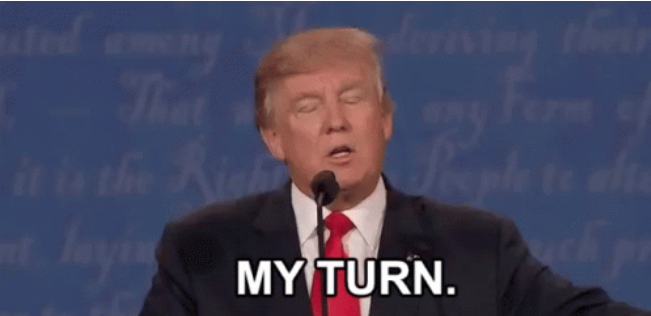The current US presidential election between Hillary Clinton and Donald Trump is an important milestone for women in politics, and, as such, is a visible arena for how such specific instances play out and contribute to the historical exclusion of women. An examination of an excerpt of their final debate informed by Fairclough (2014) shows how Trump’s use of language toward Clinton works to establish precedents that further marginalize women from the political sphere.
(2) punctuate utterances) but he has-
(3) Wallace: -let’s-
(4) Clinton: given jobs to Chinese steelworkers, not American steelworkers.
(5) Wallace: -Mr. Trump-
(6) Clinton: That’s the kind of approach
(7) Trump: -Well, let me just say, let me just say-
(8) C: that is just not going to work.
(9) T: -it just-
(10) C: (speaking quicker) We’re gonna’ pull the country together. We’re gonna’ have trade
(11) agreements that we enforce, that’s why I’m going to have a trade prosecutor for the first (12) time in
history. And we’re going to enforce those agreements and we’re going ta
(13) W: -Sec-
(14) C: look for businesses, uh,
(15) W: -Secretary Clinton-
(16) C: to help us by buying American products.
(17) W: (incomprehensible) Mr. Trump.
(18) T: I ask a simple question: she’s been doin’ this for thirty years – (turning to face Clinton) (19) why the hell
didn’t you do it over the last – fifteen, twenty years?
(20) C: -you know-
(21) T: (turning slightly away from Clinton) you were
(22) C: -I voted-
(23) T: (facing audience) very much involved –– excuse me – my turn… You were very much (24) involved in
every aspect of this country…
What immediately stands out about this exchange is how each candidate deals with being interrupted. Clinton rushes to complete her thought, while Trump stops his speech to silence his opponent. Trump’s reprimanding of Clinton here delegitimizes her as a candidate and furthers the trends that lead to such small representation of women in US politics. As Fairclough (2014) puts forward, language and society have “an internal and dialectical relationship” (p. 56); in other words, societal trends and expectations shape language use, but language use also shapes these same societal trends and expectations. What is of interest here is not so much how gender fits into the first part of this dialectic and how it played out at the debate – though examining the sexism and sexist expectations of each candidate would be a meaningful project – but, rather, how gender in politics will be impacted by the dialectic’s second aspect.
Even if Trump’s outburst is merely the result of individualized hypocrisy on his part, or his feeling that his interruptions in the exchange were valid because they were prompted by the moderator (line 5), to imply that Clinton is either unaware of how debates are organized or is purposefully going against their rules holds many more implications than mere annoyance at being interrupted. It is one thing to be upset with Clinton’s interruptions, but to speak down to a candidate who, in the same breath one admits has been “very much involved with every aspect of this country” for thirty years, is to be particularly condescending. Obviously, I do not expect Trump to build his opponent up, but considering that language use provides precedents for future language use, how underrepresented women are in politics as a whole, and the fact that Clinton is the first ever female candidate for president from a major political party, to be so openly condescending is to set precedents of language use toward female candidates that will hurt their chances of winning and lead to the further underrepresentation of women in public office.
I do not want to imply that in one condescending utterance Donald Trump somehow entirely doomed how women will be viewed in the political sphere, merely that one outburst in such a public scenario helps keep in motion sexist social stigmas and notions of gender roles that, as long as they are prominent, will keep women from political success. Even non-overtly sexist language is sexist if it is used by an individual representing a historically privileged group to demean the political career and legitimacy of someone not benefiting from the same privilege. Language shapes society, and Trump’s language is no different. As he and other men involved in politics (candidates, pundits, analysts, et cetera) continue to casually call into question the validity of women’s knowledge of political discourse (in this case the debate), even if they don’t realize it, they are acting within and to further precedents that bar women from politics and ensure their underrepresentation in public office.
Works Cited
- “Current Numbers,” (2016) Retrieved from http://www.cawp.rutgers.edu.
- Fairclough, Norman (2014). Discourse as Social Practice. Language and Power (pp. 51-72). New York, NY: Longman.
- “Quick Facts,” (n.d.) Retrieved from http://www.census.gov.
- [The New York Times]. (2016, October 19). Final 2016 Presidential Debate (Full) | The New York Times. [Video File]. Retrieved from https://www.youtube.com/watch?v=Z_pEb1bDN-w
Hayden is a student in the introductory sociolinguistics course at Swarthmore College.


 RSS Feed
RSS Feed